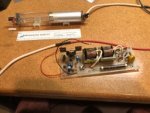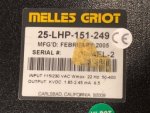I need some help on my ballast resistor.
I bought a "1 mW" HeNe laser at the Dayton Hamvention electronics flea market around 1990 ! It had a tube and a power supply "kit" which consisted of a printed circuit board and components that you put together. Everything was fine, and, I was able to get it working back in the day. Also, it still works today ! But, for anything other than careful bench use, I really needed an enclosure for the power supply.
So I recently bought a surplus Melles Griot power supply, which fires the tube just fine. My only problem, the ballast resistor runs too hot and I have to shut it down after ~1 minute or so. I suspect the Melles Griot power supply is too powerful.
a) Can you confirm my thinking that the power supply is too powerful?
b) Can this be solved without discarding the Melles Griot power supply? It appears to be a nice little unit.
The tube is unmarked.
The instructions that originally came with the laser lists these additional specs:
- start voltage approx 8-10 kV
- run voltage approx 1-2 kV at 3 - 4.5 mA
..that's it.
The Melles Griot power supply is a 25-LHP-151-249 and lists these specs on the label:
- output: 1.85 - 2.45 kVDC
- 6.5 mA
So. I don't remember the original power supply having a limited "on time". I seem to remember I could run it for 5+ minutes, then I'd get bored. With the new supply, it definitely gets hot!
The original ballast resistor was a 1W rated 121K resistor. With the Melles Griot supply, the resistor got hot enough to start to smoke the heat shrink tubing I had on the resistor. Next, I got a selection of Mouser 3W resistors. I ran at 150K and 200K and both times the resistors got hot enough to melt the small amount of solder I had tacked the hight voltage wire with.
I would have thought that the 200K resistor would have limited the current enough to reduce the power. I probably need to think through Ohm's law here!
Any thoughts?
I bought a "1 mW" HeNe laser at the Dayton Hamvention electronics flea market around 1990 ! It had a tube and a power supply "kit" which consisted of a printed circuit board and components that you put together. Everything was fine, and, I was able to get it working back in the day. Also, it still works today ! But, for anything other than careful bench use, I really needed an enclosure for the power supply.
So I recently bought a surplus Melles Griot power supply, which fires the tube just fine. My only problem, the ballast resistor runs too hot and I have to shut it down after ~1 minute or so. I suspect the Melles Griot power supply is too powerful.
a) Can you confirm my thinking that the power supply is too powerful?
b) Can this be solved without discarding the Melles Griot power supply? It appears to be a nice little unit.
The tube is unmarked.
The instructions that originally came with the laser lists these additional specs:
- start voltage approx 8-10 kV
- run voltage approx 1-2 kV at 3 - 4.5 mA
..that's it.
The Melles Griot power supply is a 25-LHP-151-249 and lists these specs on the label:
- output: 1.85 - 2.45 kVDC
- 6.5 mA
So. I don't remember the original power supply having a limited "on time". I seem to remember I could run it for 5+ minutes, then I'd get bored. With the new supply, it definitely gets hot!
The original ballast resistor was a 1W rated 121K resistor. With the Melles Griot supply, the resistor got hot enough to start to smoke the heat shrink tubing I had on the resistor. Next, I got a selection of Mouser 3W resistors. I ran at 150K and 200K and both times the resistors got hot enough to melt the small amount of solder I had tacked the hight voltage wire with.
I would have thought that the 200K resistor would have limited the current enough to reduce the power. I probably need to think through Ohm's law here!
Any thoughts?






